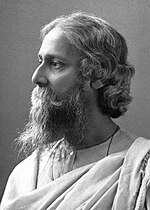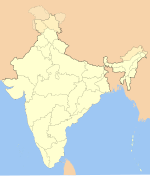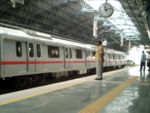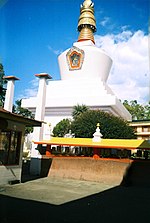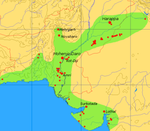Portal:India/Today's selected article/May 2006
| This page is currently inactive and is retained for historical reference. Either the page is no longer relevant or consensus on its purpose has become unclear. To revive discussion, seek broader input via a forum such as the village pump. |
Today's selected article for Indian Portal archive
2005 –
2006 – 2007
January - February - March - April - May - June - July - August - September - October - November - December
(Today is Monday, 11 November2024; it is now 08:12 UTC)
Selected content:
Selected article tools:
| << | Today's selected articles for May 2006 | >> | ||||
|---|---|---|---|---|---|---|
| Su | Mo | Tu | We | Th | Fr | Sa |
| 1 | 2 | 3 | 4 | 5 | 6 | |
| 7 | 8 | 9 | 10 | 11 | 12 | 13 |
| 14 | 15 | 16 | 17 | 18 | 19 | 20 |
| 21 | 22 | 23 | 24 | 25 | 26 | 27 |
| 28 | 29 | 30 | 31 | |||
| An archive of Portal:India's selected articles that appeared on the Portal:India | ||||||
- May 1
| This page is currently inactive and is retained for historical reference. Either the page is no longer relevant or consensus on its purpose has become unclear. To revive discussion, seek broader input via a forum such as the village pump. |
Black pepper is a flowering vine in the family Piperaceae, cultivated for its fruit, which is usually dried and used as a spice and seasoning. Black pepper is native to southern India and is extensively cultivated there and elsewhere in tropical regions. The fruit is a small drupe five millimetres in diameter, dark red when fully mature, containing a single seed. Dried and ground pepper is one of the most common spices in European cuisine and its descendants, having been known and prized since antiquity for both its flavour and its use as a medicine. The spiciness of black pepper is due to the chemical piperine. Ground black peppercorn, usually referred to simply as "pepper", may be found on nearly every dinner table in some parts of the world, often alongside its frequent companion, table salt. (more...)
Recently appeared: GNU/Linux naming controversy – Saffron – Graffiti
- May 2
Rabindranath Tagore May 7, 1861 – August 7, 1941, also known by the sobriquet Gurudev, was a Bengali poet, Brahmo (syncretic Hindu monotheist) philosopher, visual artist, playwright, composer, and novelist whose avant-garde works reshaped Bengali literature and music in the late 19th and early 20th centuries. A celebrated cultural icon of Bengal, he became Asia's first Nobel laureate when he won the 1913 Nobel Prize in Literature.
A Calcuttan Pirali Brahmin by birth, Tagore began writing poems at the age of eight; he published his first substantial poetry — using the pseudonym "Bhānusiṃha" ("Sun Lion") — in 1877 and wrote his first short stories and dramas at age sixteen. His home schooling, life in Shelidah, and extensive travels made Tagore an iconoclastic pragmatist; however, growing disillusionment with the British Raj caused the internationalist Tagore to back the Indian Independence Movement and befriend Mahatma Gandhi. Despite the loss of virtually his entire family and his regrets regarding Bengal's decline, his life's work — Visva-Bharati University — endured.
(more...)
Recently appeared: Black pepper – GNU/Linux naming controversy – Saffron
- May 3
| This page is currently inactive and is retained for historical reference. Either the page is no longer relevant or consensus on its purpose has become unclear. To revive discussion, seek broader input via a forum such as the village pump. |
Bangalore is the capital of the Indian state of Karnataka. Bangalore is located on the Mysore Plateau in southwestern Karnataka. With an estimated metropolitan population of 6.1 million (2006), it is India's third-largest city and fifth-largest metropolitan area. Though historical references to the city predate 900, a modern written history of continuous settlement exists only from 1537, when Kempe Gowda I, who many regard as the architect of modern Bangalore, built a mud fort in the city and established it as a province of the imperial Vijayanagara Empire. The city's temperate climate, which is milder than the those of other cities in the country, has been a major attraction to people from other parts of India. After India gained independence in 1947, Bangalore evolved into a manufacturing hub for public sector heavy industries — prominently aerospace, space and defence industries. Bangalore is referred to as the "Silicon Valley of India" and has the second-highest literacy rate in the nation. However, as a large and growing metropolis in the developing world Bangalore continues to struggle with problems such as air pollution, traffic congestion, and crime. (continued...)
Recently appeared: Rabindranath Tagore – Black pepper – GNU/Linux naming controversy
- May 4
| This page is currently inactive and is retained for historical reference. Either the page is no longer relevant or consensus on its purpose has become unclear. To revive discussion, seek broader input via a forum such as the village pump. |
The political integration of India established a united nation for the first time in thousands of years from a plethora of princely states, colonial provinces and possessions. Despite partition, a new India arose above demographic distinctions to unite peoples of various geographic, economic, ethnic, linguistic and religious backgrounds. India was transformed after independence through political upheaval and ethnic discontent, and continues to evolve as a federal republic natural to its diversity. The process is defined by sensitive religious conflicts between Hindus and Muslims, diverse ethnic populations, as well as by geo-political rivalry and military conflicts with Pakistan and China. When the Indian independence movement succeeded in ending British Raj on August 15, 1947, India's leaders faced the prospect of inheriting a nation fragmented between medieval-era kingdoms and provinces organized by colonial powers. Under the leadership of Sardar Vallabhbhai Patel, one of India's most respected freedom fighters and the Minister of Home Affairs, the new Government of India employed frank political negotiations backed with the option of military action to weld a nation. (more...)
Recently appeared: Mozilla Firefox – Dinosaur – Black pepper
- May 5
| This page is currently inactive and is retained for historical reference. Either the page is no longer relevant or consensus on its purpose has become unclear. To revive discussion, seek broader input via a forum such as the village pump. |
Kalimpong is a hill station nestled in the Shiwalik Hills in the Indian state of West Bengal. The town is the headquarters of the Kalimpong subdivision, a part of the district of Darjeeling. A major forward base of the Indian Army is located on the outskirts of the town. Kalimpong is well-known for its many educational institutions, which attract students from all over North East India, West Bengal, Bhutan, Nepal, and Bangladesh. In recent times, Kalimpong has become an important tourist destination owing to its temperate climate and proximity to popular tourist locations in the region. Kalimpong is also famous for its flower market, especially the wide array of orchids. It houses several Buddhist monasteries holding a number of rare Tibetan Buddhist scriptures.(more...)
Recently appeared: political integration of India – Mozilla Firefox – Dinosaur
- May 6
| This page is currently inactive and is retained for historical reference. Either the page is no longer relevant or consensus on its purpose has become unclear. To revive discussion, seek broader input via a forum such as the village pump. |
Kerala is a state on the southwestern tropical Malabar Coast of India. To its east and northeast, Kerala borders Tamil Nadu and Karnataka; to its west and south lie the Indian Ocean islands of Lakshadweep and the Maldives, respectively. Kerala also envelops Mahé, a coastal exclave of the Union Territory of Pondicherry. In prehistory, Kerala's rainforests and wetlands — then thick with malaria-bearing mosquitoes and man-eating tigers — were largely avoided by Neolithic humans. More than a millennium of overseas contact and trade culminated in four centuries of struggle between and among multiple colonial powers and native Keralite states. Kerala was granted statehood on November 1, 1956. Radical social reforms begun in the 19th century by the kingdoms of Kochi and Travancore — and spurred by such leaders as Narayana Guru and Chattampi Swamikal — were continued by post-Independence governments, making Kerala among the Third World's longest-lived, healthiest, and most literate regions. Kerala's 31.8 million people now live under a stable democratic socialist political system and exhibit unusually equitable gender relations.(more...)
Recently appeared: Kalimpong – political integration of India – Mozilla Firefox
- May 7
| This page is currently inactive and is retained for historical reference. Either the page is no longer relevant or consensus on its purpose has become unclear. To revive discussion, seek broader input via a forum such as the village pump. |
Indian Railways is the state-owned railway company of India; it has a complete monopoly over the country's rail transport. Indian Railways (IR) has one of the largest and busiest rail networks in the world, transporting over 5 billion passengers and over 350 million tonnes of freight annually. IR is also the world's largest commercial or utility employer, having more than 1.6 million regular employees on its payroll. Railways were first introduced to India in 1853, and by 1947, the year of India's independence, it had grown to forty-two rail systems. In 1951 the systems were nationalised as one unit, to become one of the largest networks in the world. Indian Railways operates both long distance, as well as suburban rail systems. It operates 8,702 passenger trains and transports around five billion annually across twenty-seven states and three union territories (Delhi, Pondicherry and Chandigarh). Sikkim is the only state not connected. The Railway Budget deals with the induction and improvement of existing trains and routes, the modernisation and most importantly the tariff for freight and passenger travel. (more...)
Recently appeared: Kerala – Kalimpong – political integration of India
- May 8
| This page is currently inactive and is retained for historical reference. Either the page is no longer relevant or consensus on its purpose has become unclear. To revive discussion, seek broader input via a forum such as the village pump. |
Gangtok is the capital and largest town of the Indian state of Sikkim. It is situated in the lower Himalayas. Known for its clean surroundings and temperate climate, this hill station of about fifty thousand people is the centre of Sikkim's tourist industry. Gangtok was a small hamlet until the construction of the Enchey Monastery in 1840 made it a pilgrimage center. It became a major stopover between Tibet and British India at the end of the 19th century. Following India's independence in 1947, Sikkim became a nation-state with Gangtok as its capital. In 1975 the monarchy was abrogated and Sikkim became India's twenty-second state, with Gangtok remaining as its capital. City is also a centre of Tibetan Buddhist culture and learning with numerous monasteries and religious educational institutions. Gangtok is connected to the rest of India by an all-weather metalled highway, NH-31A, which links Gangtok to Siliguri. The civic infrastructure of Gangtok is overseen by the local municipal corporation whose councillors are directly elected by the people. The rural roads around Gangtok however, are maintained by the Border Roads Organisation, which is a part of the Indian army. (more...)
Recently appeared: Indian Railways – Kerala – Kalimpong
- May 9
| This page is currently inactive and is retained for historical reference. Either the page is no longer relevant or consensus on its purpose has become unclear. To revive discussion, seek broader input via a forum such as the village pump. |

The Governor-General of India was the head of the British administration in India. The office was created in 1773, with the title of Governor-General of the Presidency of Fort William. The officer had direct control only over Fort William, but supervised other British East India Company officials in India. Complete authority over all of British India was granted in 1833, and the official became known as the Governor-General of India. In 1858, India came under the direct control of the British Crown, and the Governor-General acted as the Sovereign's representative. To reflect this role, the term "Viceroy" was informally applied; the title was abandoned when India became independent in 1947. The office of Governor-General continued to exist until India adopted a constitution in 1950. Governors-General served five-year terms, but could be removed earlier. After the conclusion of a term, a provisional Governor-General was sometimes appointed until a new holder of the office could be chosen. Provisional Governors General were often chosen from among the provincial Governors. (more...)
Recently appeared: Gangtok – Indian Railways – Kerala
- May 10
Chennai, also known as Madras, is the capital of the state of Tamil Nadu and is India's fourth largest metropolitan city. It is located on the Coromandel Coast of the Bay of Bengal. With an estimated population of 6.90 million, the 367-year-old city is the 31st largest metropolitan area in the world. The city is a large commercial and industrial centre, and is known for its cultural heritage and temple architecture. The city is the automobile capital of India, with around forty percent of the automobile industry having a base there. The 12 kilometre long Marina Beach forms the city's east coast and is one of the longest beaches in the world. The city is also known for its sport venues and hosts India's only ATP tennis event, the Chennai Open. Chennai is located on a flat coastal plain known as the Eastern Coastal Plains. The city has an average elevation of 6 metres, its highest point being 60 m. City is governed by the Corporation of Chennai, which consists of a Mayor and 155 Councillors representing the 155 Wards. Chennai's culture reflects its diverse population. The city is known for its classical dance shows and Hindu temples. (more...)
Recently appeared: Governor-General of India – Gangtok – Indian Railways
- May 11
Indian Air Force is the air-arm of the Armed Forces of India and has the prime responsibility of conducting air-based warfare and securing Indian airspace. It was established on October 8, 1932 as the Royal Indian Air Force. The prefix Royal was dropped after India became a Republic in 1950. It is the fourth largest air force in the world. It has a strength of 750+ combat aircraft and presently operates with a total of 42 squadrons. The Sukhoi is the IAF's prime air superiority combat aircraft. The IAF currently possesses several multi-role fighter jets that perform these functions. Single-seater Mirage 2000 and MiG-29 serve both strike and defense squadrons. The IAF currently possesses 100 Jaguar IM and 20 maritime strike Jaguar IS aircraft. In 2003, the IAF bought 6 IL-78 aircraft from Russia. The aircraft's primary role is mid-air re-fueling. It currently operates IAI Malat-built Searcher MkII and Heron UAVs. An important objective of the IAF is to support ground troops by providing air-cover and by transporting men and essential commodities across the battlefield. (more...)
Recently appeared: Chennai – Governor-General of India – Gangtok
- May 12
Himalaya is a mountain range in Asia, separating the Indian subcontinent from the Tibetan Plateau. By extension, it is also the name of the massive mountain system which includes the Himalaya proper, the Karakoram, the Hindu Kush. Together, the Himalaya mountain system is the planet's highest and home to all fourteen of the world's highest peaks. the Eight-thousanders, including Mount Everest. To comprehend the enormous scale of Himalaya peaks, consider that Aconcagua, in the Andes, is at 6,959 m the highest peak outside the Himalaya, while the Himalaya system has over 100 peaks exceeding 7,200 m. The Himalaya stretches across five nations, Bhutan, China, India, Nepal, and Pakistan. It is the source of three of the world's major river systems, the Indus Basin, the Ganga-Brahmaputra Basin and the Yangtze Basin. An estimated 750 million up people live in the watershed area of the Himalayan rivers, which also includes Bangladesh. (more...)
Recently appeared: Indian Air Force – Chennai – Governor-General of India
- May 13
Jawaharlal Nehru was an important leader of Indian Independence Movement and Indian National Congress. He became the first Prime Minister when India won its independence on August 15, 1947. In 1952, India held its first democratic national elections, and he led the Congress Party to a sweeping majority in the Parliament of India. He was leading a combination of old and young Indians all energized by patriotism and the opportunity to finally put their dreams and vision for India into practice. His years were generally peaceful, with the generation of freedom-fighters controlling the Union and state governments and political parties. He also sired the most powerful political dynasty in India's modern history. His daughter Indira Gandhi would become Prime Minister within two years of his death in 1966, and would serve for 15 years and 3 terms. His grandson Rajiv Gandhi would hold that office from 1984 to 1989. (more...)
Recently appeared: Himalaya – Indian Air Force – Chennai
- May 14
| This page is currently inactive and is retained for historical reference. Either the page is no longer relevant or consensus on its purpose has become unclear. To revive discussion, seek broader input via a forum such as the village pump. |
Hindi. a Indo-European language spoken mainly in North, Central, and Western India, is one of the national languages of India. It is part of a dialect continuum of the Indo-Aryan family. Hindi also refers to a standardized register of Hindustani that was made one of the official languages of India. The grammatical description in this article concerns standard Hindi. It evolved from Sanskrit, by way of the Middle Indo-Aryan Prakrit languages and Apabhramsha of the Middle Ages. As a standardised register of India, it became the national language of India on January 26, 1950. Hindi is often contrasted with Urdū. The primary differences between the two are that Standard Hindi is written in Devanāgarī which is written from left to right. The Devanagari script represents the sounds of spoken Hindi very closely, so that a person who knows the Devanagari letters can sound out a written Hindī text comprehensibly, even without knowing what the words mean and has supplemented some of its Persian and Arabic vocabulary, with words from Sanskrit; while Urdu is written in nastaliq script, a variant of the Persio-Arabic script, and draws heavily on Persian and Arabic vocabulary. (more...)
Recently appeared: Jawaharlal Nehru – Himalaya – Indian Air Force
- May 15
| This page is currently inactive and is retained for historical reference. Either the page is no longer relevant or consensus on its purpose has become unclear. To revive discussion, seek broader input via a forum such as the village pump. |
Lothal was one of the most prominent cities of the ancient Indus valley civilization. Located in the modern state of Gujarat and dating from 2400 BCE, it is India's most important archaeological site that dates from that era. Lothal's dock—the world's earliest—connected the city to an ancient course of the Sabarmati river on the trade route between Harappan cities in Sindh and the peninsula of Saurashtra when the surrounding Kutch desert of today was a part of the Arabian Sea. It was a vital and thriving trade centre in ancient times, with its trade of beads, gems and valuable ornaments reaching the far corners of West Asia and Africa. Discovered in 1954, Lothal was excavated from February 13, 1955 to May 19, 1960 by the Archaeological Survey of India (ASI). A major part of the township and dockyard were unearthed. Resuming excavation in 1961, archaeologists unearthed trenches sunk on the northern, eastern and western flanks of the mound, bringing to light the inlet channels and nullah ("ravine", or "gully") connecting the dock with the river. The findings consist of a mound, a township, a marketplace and the dock. Adjacent to the excavated areas stands the Archaeological Museum, where some of the most prominent collections of Indus-era antiquities in modern India are displayed.
- The selected article for this day has not been chosen yet. See Portal:India/Today's selected article for guidelines.
Recently appeared: Hindi – Jawaharlal Nehru – Himalaya
- May 16
Malwa (Malvi:माळवा) is a region in western India occupying a plateau of volcanic origin in the western part of Madhya Pradesh state and the south-eastern part of Rajasthan. This region has been a separate political unit from the time of the Aryan tribe of Malavas until 1947, when the British Malwa Agency was merged into Madhya Bharat. Although political borders have fluctuated throughout history, the region has developed its own distinct culture and language. The plateau that forms a large part of the region is named the Malwa Plateau, after the region. The average elevation of the Malwa plateau is 500 metres, and the landscape generally slopes towards the north. Most of the region is drained by the Chambal River and its tributaries; the western part is drained by the upper reaches of the Mahi River. Ujjain was the political, economic, and cultural capital of the region in ancient times, and Indore is presently the largest city and commercial centre. Overall, agriculture is the main occupation of the people of Malwa. The region has been one of the important producers of opium in the world. Cotton and soybeans are other important cash crops, and textiles are a major industry. (More...)
Recently appeared: Lothal – Hindi – Jawaharlal Nehru
- May 17
| This page is currently inactive and is retained for historical reference. Either the page is no longer relevant or consensus on its purpose has become unclear. To revive discussion, seek broader input via a forum such as the village pump. |
The BEST (Marathi: बेस्ट) or the Brihanmumbai Electricity Supply and Transport is Mumbai's public transport service and electricity provider. The government-owned organisation, which was set up in 1873, operates one of India's largest fleet of buses. Originally setup as a tramway company, it branched out into supplying electricity to the city in 1905, and later into operating buses in 1926. The BEST is run by the city's municipality as an autonomous body.
The bus transport service covers the entire city and also extends its operations outside city limits into neighbouring Navi Mumbai, Thane and Mira-Bhayandar. In addition to buses, it also operates a ferry service in the northern reaches of the city. The electricity division of the organisation is also one of the few electricity departments in India to garner an annual net profit.
Until 1995, BEST stood for Bombay Electricity Supply and Transport. After the name of the city was formally changed from Bombay to Mumbai, this was also reflected with the adjustment to Brihanmumbai, which means "Greater Mumbai". (More...)
Recently appeared: Malwa – Lothal – Hindi
- May 18
- The selected article for this day has not been chosen yet. See Portal:India/Today's selected article for guidelines.
Recently appeared: [[]] – [[]] – [[]]
- May 19
| This page is currently inactive and is retained for historical reference. Either the page is no longer relevant or consensus on its purpose has become unclear. To revive discussion, seek broader input via a forum such as the village pump. |
The Indian cricket team is an international cricket team representing India. It is governed by the Board of Control for Cricket in India, the main cricketing governing body in India. Cricket is the de facto national sport of India, with a huge fan base.
The Indian cricket team made its debut in Test cricket, the highest level of international cricket, on June 25, 1932 at Lord's, England, becoming the sixth Test team. For nearly fifty years, the India was weaker than most of the other Test cricket teams, such as Australia and England. The team gained strength in the 1970s with the emergence of players such as Sunil Gavaskar and Kapil Dev and the Indian spin quartet, and the Indian team has continued to be highly ranked since then in both Test cricket and One-day Internationals. The team won the Cricket World Cup in 1983 and were runners-up in 2003. The current team contains many of the world's leading players, including Sachin Tendulkar. As of 9 April 2006, the team is ranked third in the ICC Test Championship and third in the ICC ODI Championship. (continued...)
Recently appeared: Brihanmumbai Electric Supply and Transport – Malwa – Lothal
- May 20
| This page is currently inactive and is retained for historical reference. Either the page is no longer relevant or consensus on its purpose has become unclear. To revive discussion, seek broader input via a forum such as the village pump. |
Lothal was one of the most prominent cities of the ancient Indus Valley Civilization. Located in the state of Gujarat in India, it was discovered in 1954, and its existence dates from 2400 BCE. Lothal's dock—the world's earliest—made the city a vital centre of trade between Harappan cities, West Asia and Africa. The dock, its wharf, lock-gate system, and sophisticated drainage system are unusual marvels of engineering. Lothal yielded the most important Indus-era antiquities in modern India. Its scientists divided the horizon and sky into 8–12 whole parts, pioneering the study of stars and advanced navigation. (continued...)
Recently appeared: Indian cricket team – Brihanmumbai Electric Supply and Transport – Malwa
- May 21
| This page is currently inactive and is retained for historical reference. Either the page is no longer relevant or consensus on its purpose has become unclear. To revive discussion, seek broader input via a forum such as the village pump. |
Bangalore is the capital of the Indian state of Karnataka. Bangalore is located on the Mysore Plateau in southwestern Karnataka. With an estimated metropolitan population of 6.1 million (2006), it is India's third-largest city and fifth-largest metropolitan area. Though historical references to the city predate 900, a modern written history of continuous settlement exists only from 1537, when Kempe Gowda I, who many regard as the architect of modern Bangalore, built a mud fort in the city and established it as a province of the imperial Vijayanagara Empire. The city's temperate climate, which is milder than that of other cities in the country, has been a major attraction to people from other parts of India. After India gained independence in 1947, Bangalore evolved into a manufacturing hub for public sector heavy industries — prominently aerospace, space and defence industries. Bangalore is referred to as the "Silicon Valley of India" and has the second-highest literacy rate in the nation. However, as a large and growing metropolis in the developing world Bangalore continues to struggle with problems such as air pollution, traffic congestion, and crime. (continued...)
Recently appeared: Lothal – Indian cricket team – Brihanmumbai Electric Supply and Transport
- May 22
| This page is currently inactive and is retained for historical reference. Either the page is no longer relevant or consensus on its purpose has become unclear. To revive discussion, seek broader input via a forum such as the village pump. |
Cricket is a team sport. The game, sometimes referred to as the "gentleman's game", originated in its formal form in England, and is popular mainly in the countries of the Commonwealth. In the countries of South Asia, including India and Pakistan, cricket is by far the most popular participatory and spectator sport. It is also the national sport of Australia, and it is the major summer sport in New Zealand, South Africa, and the United Kingdom. The rich jargon of cricket can often leave those unfamiliar with the game confused; the rules are of similar complexity to those of its cousin baseball. Cricket fosters die-hard aficionados, for whom matches provide passionate entertainment. Occasionally, rival nations have lampooned each other over cricket matches, provoking diplomatic outrage.
Recently appeared: Bangalore – Lothal – Indian cricket team
- May 23
- The selected article for this day has not been chosen yet. See Portal:India/Today's selected article for guidelines.
Recently appeared: [[]] – [[]] – [[]]
- May 24
- The selected article for this day has not been chosen yet. See Portal:India/Today's selected article for guidelines.
Recently appeared: [[]] – [[]] – [[]]
- May 25
- The selected article for this day has not been chosen yet. See Portal:India/Today's selected article for guidelines.
Recently appeared: [[]] – [[]] – [[]]
- May 26
- The selected article for this day has not been chosen yet. See Portal:India/Today's selected article for guidelines.
Recently appeared: [[]] – [[]] – [[]]
- May 27
| This page is currently inactive and is retained for historical reference. Either the page is no longer relevant or consensus on its purpose has become unclear. To revive discussion, seek broader input via a forum such as the village pump. |
Portal:India/Selected articles/SC Summary/SA Kargil War
Recently appeared: Cricket – Bangalore – Lothal
- May 28
| This page is currently inactive and is retained for historical reference. Either the page is no longer relevant or consensus on its purpose has become unclear. To revive discussion, seek broader input via a forum such as the village pump. |
Portal:India/Selected articles/SC Summary/SA British East India Company
Recently appeared: Kargil War – Cricket – Bangalore
- May 29
| This page is currently inactive and is retained for historical reference. Either the page is no longer relevant or consensus on its purpose has become unclear. To revive discussion, seek broader input via a forum such as the village pump. |
Recently appeared: British East India Company – Kargil War – Cricket
- May 30
| This page is currently inactive and is retained for historical reference. Either the page is no longer relevant or consensus on its purpose has become unclear. To revive discussion, seek broader input via a forum such as the village pump. |
Portal:India/Selected articles/SC Summary/SA Geography of India
Recently appeared: Fundamental Rights, Directive Principles and Fundamental Duties of India – British East India Company – Kargil War
- May 31
| This page is currently inactive and is retained for historical reference. Either the page is no longer relevant or consensus on its purpose has become unclear. To revive discussion, seek broader input via a forum such as the village pump. |
Portal:India/Selected articles/SC Summary/SA Mahatma Gandhi
Recently appeared: Geography of India – Fundamental Rights, Directive Principles and Fundamental Duties of India – British East India Company
Today's selected article for Indian Portal archive
2005 –
2006 – 2007
January - February - March - April - May - June - July - August - September - October - November - December
(Today is Monday, 11 November2024; it is now 08:12 UTC)


